Heading out the door? Read this article on the new Outside+ app available now on iOS devices for members! Download the app.
Ask people what motivates them to practice yoga and you’ll hear an array of responses. “Stress relief” and “spiritual growth” are common refrains. You’ll also hear “improved flexibility” an “relief from low back pain.” What you probably won’t hear? “I practice yoga for osteoporosis” or “strong bones.”
Yet research suggests that practicing yoga can be surprisingly protective in preventing fractures and osteoporosis, a condition that will cause approximately 50 percent of women age 50 or older to experience related complications. Men can be afflicted by osteoporosis as well, although 80 percent of sufferers are female. This is likely due to women’s propensity to have smaller, thinner skeletal structure and the sharp decline in the production of estrogen—a female hormone that protects against bone loss—that accompanies menopause.
The reality is that by the time you hit the age when your skeleton becomes more brittle, it’s much more challenging, although not impossible, to build protective bone mass. That means the best time to focus on increasing your bone mass reservoir is always now, says Loren Fishman, MD, a Columbia University physiatrist specializing in rehabilitative medicine who studied yoga under B.K.S. Iyengar.
How Yoga for Osteoporosis Creates Strong Bones
If you practice yoga, you’re already protecting your bones in several ways.
1. Engaging Your Muscles Stimulates Bone Production
For starters, each time you practice a pose, you potentially build new bone. “When you hold a pose like Supta Padangusthasana (Reclining Hand-to-Big-Toe Pose) or a twist, you’re opposing one group of muscles against another, like the quadriceps against the hamstrings or the gluteal muscles against the shoulder muscles, respectively,” says Fishman. That opposition creates a force that physically stimulates osteoblasts, bone-making cells that initially live on the outside of the bone and turn into osteocytes, which are cells that become embedded within your bone. “You’re actually laying down new bone,” explains Fishman.
Doctors previously believed that women’s ability to accrue new bone basically ended once they entered menopause, which is when levels of bone-protective estrogen and progesterone plummet. “The new research shows that yoga can outweigh the hormonal effects of age,” says Fishman.
His 2015 study, published in Topics in Geriatric Rehabilitation, found that 80 percent of older participants, most of whom had osteoporosis or its precursor, osteopenia, who practiced 12 yoga poses (often modified) a day showed improved bone density in their spine and femurs. These findings also applied to younger women with healthy skeletons.
“There is strong evidence that young osteoblasts do respond pretty vigorously to the forces generated by muscles, which is likely to put off osteopenia and osteoporosis until later in life—if it were to appear at all,” says Fishman. This is relatively new thinking in the medical world. Additional research is needed to further explore the relationship between yoga and bone creation.
2. Yoga Helps with Balance
There’s also the vital role yoga plays in preventing fractures by building stability and agility. “Yoga improves your physical balance and flexibility, which means you’re less likely to fall and break something—and if you do start to fall, your agility may help you catch yourself,” says Lori Rubenstein Fazzio, DPT, yoga therapist and clinical director of the Yoga Therapy Rx Practicum at Loyola Marymount University (LMU) and part-time faculty in LMU’s Master of Arts in Yoga Studies.
Equally important, yoga also enhances your mental balance. “It makes you more present and focused,” says Rubenstein Fazzio. The rationale is that alert people are less likely to slip on an ice patch or trip on a rug.
3. Yoga Eases Anxiety (Yes, This Affects Bone Health)
When the stress hormone cortisol is chronically elevated in your system, it breaks down bone, explains Lani Simpson, DC, a certified clinical (bone) densitometrist and host of the PBS show Stronger Bones, Longer Life. Yoga’s calming qualities help lower levels of cortisol. In this way, even passive poses such as Savasana (Corpse Pose), Sukhasana (Easy Seat), and restorative yoga poses can play a role in preventing bone loss and helping counteract osteoporosis.
How to Practice Yoga for Osteoporosis
Whatever approach you take to your physical yoga practice, slow and steady delivers the strongest results. “Strength builds as you hold each pose, which you should do for as long as you comfortably can,” says Rubenstein Fazzio. Aim to hold each pose between 12 and 72 seconds, which is the range needed to stimulate osteocytes, according to Fishman.
But don’t remain in the pose so long that you tire and start to compromise your form and become lax in the pose. Muscle engagement is also critical. If your muscles aren’t pulling on that hip bone, no meaningful bone-strengthening will occur. “You want to feel your muscles tensing; that’s how you know you’re engaging—and building—them. And when you build muscle, you build bone.”
In Vrksasana (Tree Pose), for instance, make sure your pelvis is level and the knee of your standing leg faces forward. “If your hip is jutting out or your standing knee is collapsing inward, you’re probably just hanging on your ligaments and joints and not using your muscles,” explains Rubenstein Fazzio.
12-Minute Yoga for Osteoporosis Practice
The following yoga poses are believed to improve bone health, according to Fishman’s research. The cues come from from yoga therapist Terry Roth Schaff, who collaborated with Fishman on the study. You can incorporate these yoga poses into your home practice or simply try them on their own. Breathe slowly as you stay in each pose for about 30 seconds per side.
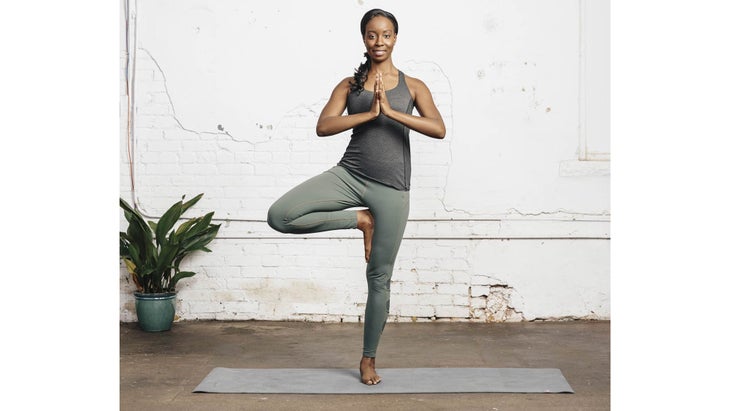
Tree Pose (Vrksasana)
Stand with your feet together in Mountain Pose (Tadasana). Bend your right knee and rotate your right thigh outward without turning your pelvis. Lift your right foot and place it somewhere along your left leg, whether at the ankle, shin, or inner thigh to come into Tree Pose (Vrksasana). Bring your palms together in front of your chest. Keep your gaze steady and straight ahead. Breathe here for as long as you can. Switch sides. You can also practice it alongside a wall or chair so you can steady yourself with one hand.
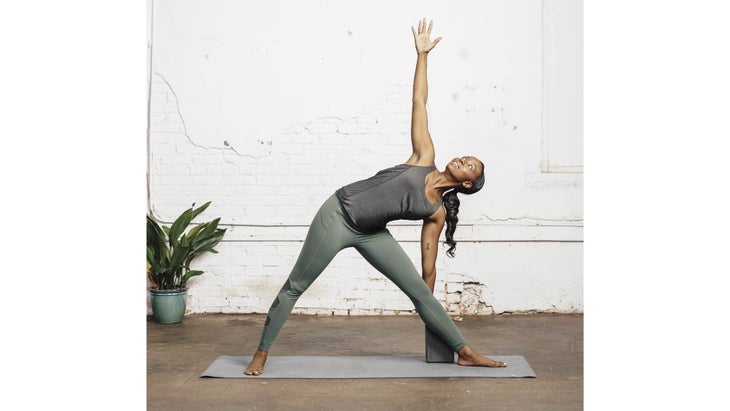
Extended Triangle Pose (Utthita Trikonasana)
From standing, turn to face the long side of the mat and angle your left foot to face the short side of the mat. Adjust your right leg so your foot and knee are angled ever so slightly toward your left side. Keep facing the long side of the mat as you lean sideways over your left leg. Place your left hand on your shin, the floor, or a block. Reach your right arm toward the ceiling in Triangle Pose. Turn your gaze toward your right hand or, it’s more comfortable, look straight ahead or take your gaze to the mat.
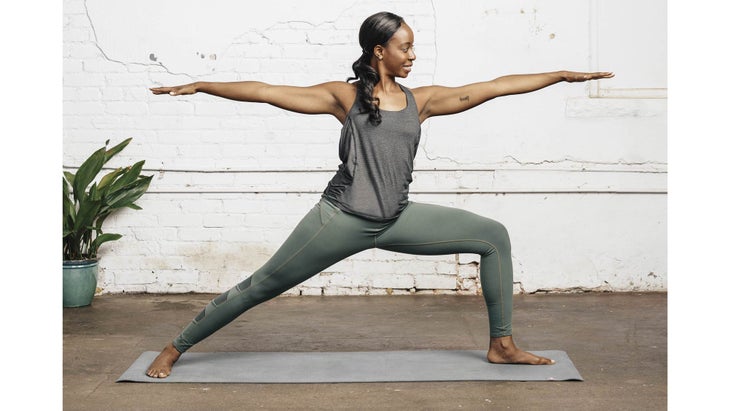
Warrior 2 Pose (Virabhadrasana II)
From Extended Triangle, bend your front knee and lift your chest upright. Reach your arms straight out from your sides at shoulder height in Warrior 2. Actively reach through your fingertips and press though the outer edge of your back foot.
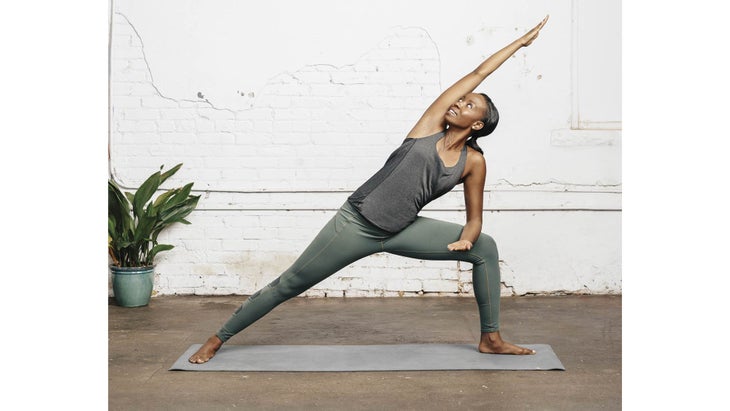
Extended Side Angle Pose (Utthita Parsvakonasana)
From Warrior 2, lengthen your torso and lower your left forearm onto your left thigh. Reach your right arm alongside your right ear in Extended Side Angle. Press down through the outer edge of your back foot and stretch along your side body through your fingertips.
Repeat the last three poses on your other side.
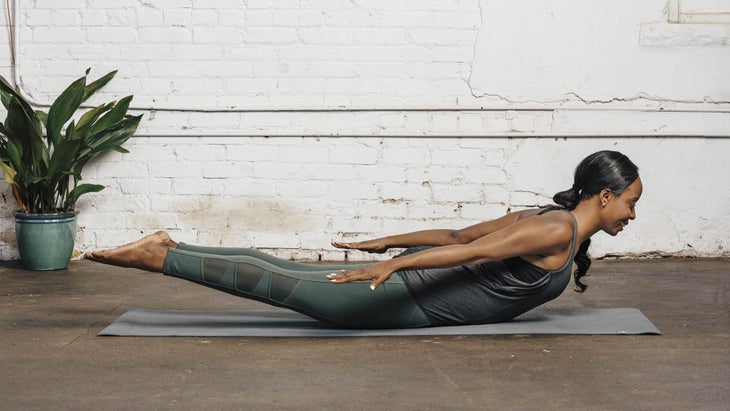
Locust Pose (Salabhasana)
Lie face-down on your mat with your arms alongside your torso and your legs hip-distance apart. Press down through the tops of your feet and lift your chest forward. Then raise your legs and reach them out behind you. Reach your arms alongside your thighs, palms facing down, in Locust Pose.
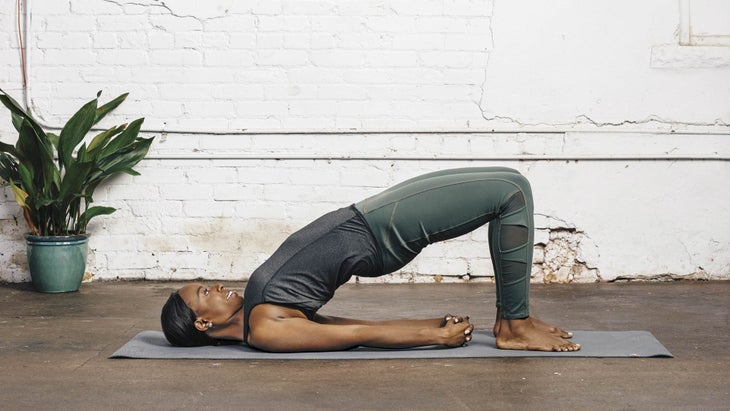
Bridge Pose (Setu Bandha Sarvangasana)
Lie on your back with your knees bent and your heels in line with your knees. Press into your feet and lift your hips and chest. Interlace your fingers behind your back and come onto your outer shoulders in Bridge Pose. Press your shoulder blades into the mat and reach your hips toward your knees.

Reclining Hand-to-Big-Toe Pose 1 (Supta Padangusthasana 1)
Lie on your back. Drape a strap around the ball of your left foot. Hold an end of the strap in each hand and straighten your left leg, reaching it toward the ceiling without lifting your left sitting bone off the mat in Reclining Hand to Big Toe Pose. Stay here for several breaths. Switch sides.
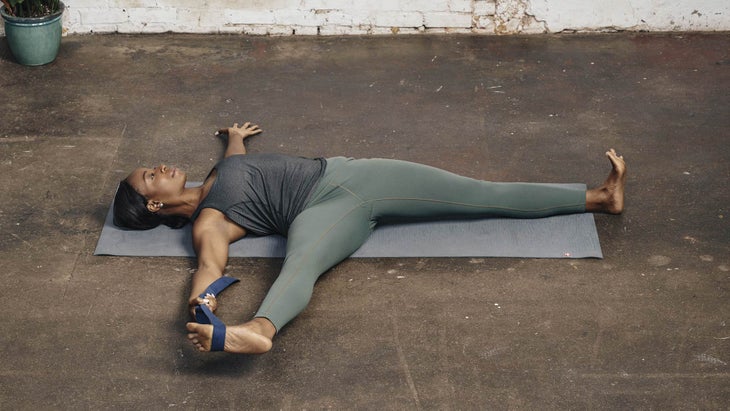
Reclining Hand-to-Big-Toe Pose 2 (Supta Padangusthasana 2)
From the previous pose, hold both ends of the strap in your right hand. Keep the back left side of your body in contact with the mat as you reach your right leg out to the right and lower it toward the floor. Pause here. Switch sides.

Savasana (Corpse Pose)
Lie on your back with your legs hip-distance apart or wider and let your feet fall open. Release your shoulder blades into the mat. Rest your arms alongside your body, palms up. Linger here.
RELATED: Why You Need Yoga, Cardio, AND Strength Training for Ultimate Bone Health